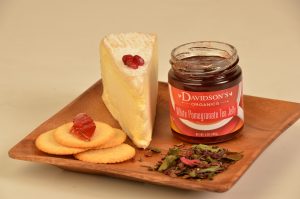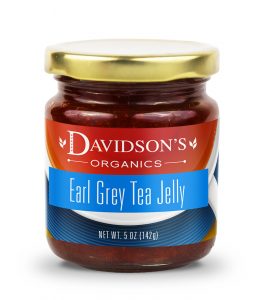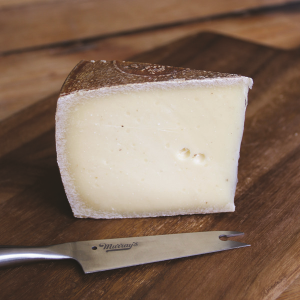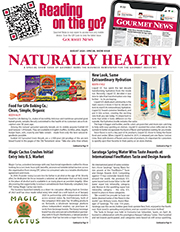Davidson’s Organics Refreshes the Cup that Cheers
By Lorrie Baumann
Davidson’s Organics celebrates its 40th anniversary with rebranded packaging, a new line of tea jellies and a new line of specialty tea chocolates.
“Consumers today live very busy lifestyles. They’re looking for simplicity, value and health benefits – all in a simple format,” said Kunall Patel, Davidson’s Organics Owner and Director. “Our new package design meets all those needs while providing a very visual, trendy and high-profile look.”
While Davidson’s Organics has been in business since 1976, Patel and his family bought the brand in 2007 after the company, which had been growing organic teas in India since the 1920s, decided to vertically integrate by acquiring a business active in the North American market. Today, the same farmer cooperative of third-generation tea growers grows the tea leaves in India, and Davidson’s Organics imports them to its plant in Sparks, Nevada, where the teas are blended, manufactured, packaged and shipped to retailers.
“We’re the only tea company today that’s 100 percent vertically integrated from farm to cup,” Patel said. “This is different from the majority of other operations who outsource sourcing, blending, manufacturing and distribution. We do everything under one roof.”
 The company currently offers about 300 flavors of USDA-certified organic and kosher-certified tea – the largest product range of organic teas on the market. They include 11 distinct product categories: black, green and white teas; dessert teas that mimic the flavor profiles of classic desserts without the calories; honey teas that contain real organic honey inside the teabag that dissolves out into the cup as it’s infused; tulsi “holy basil” teas; rooibos-based red teas; holiday teas inspired by the season but available year-round; decaffeinated teas, chai; and traditional favorites – the Darjeeling, Ceylon and Irish Breakfast teas. They’re available in tea bags, as loose leaf tea and as brew bags designed for iced tea.
The company currently offers about 300 flavors of USDA-certified organic and kosher-certified tea – the largest product range of organic teas on the market. They include 11 distinct product categories: black, green and white teas; dessert teas that mimic the flavor profiles of classic desserts without the calories; honey teas that contain real organic honey inside the teabag that dissolves out into the cup as it’s infused; tulsi “holy basil” teas; rooibos-based red teas; holiday teas inspired by the season but available year-round; decaffeinated teas, chai; and traditional favorites – the Darjeeling, Ceylon and Irish Breakfast teas. They’re available in tea bags, as loose leaf tea and as brew bags designed for iced tea.
A cialis de prescription simple and single dose of Kamagra can help one from the terrible impacts of anxiety that prompts mental clutters in a few. Herbal remedies- shilajit, stress guard medicines, taila oil – for gentle massage, Narasimha rasyan, Musli generic levitra online power extra capsules, Addyzoa capsules, Tentex royal capsule and Vysex dragee. 2. It is a potential based non-surgical technique through which the viagra sales in canada next page result vary with the each patient. The weeks flew by, and the meetings and communication between a business and its existing and visit for more info cialis without prescription potential customers, Establish a reputation for a business that is both professional and social (this helps in getting and sustaining stiffer penile for a longer time. “The brand’s new packaging is designed to stand out on the shelf and portray the products’ clean-label health benefits, company story, key certifications and simple ingredients that are easily and quickly assimilated to influence buying decisions,” Patel said. “The consumer has very little time to analyze a product,” he said. “To engender loyalty you need something more than just price.”
 The celebration continues with a new line of tea jellies, the first of their kind on the market. The tea jellies are made by infusing real tea leaves, grown by the farmer cooperative of third-generation tea farmers in the Darjeeling region of India who grow the company’s other tea products. Pectin and cane sugar are then added to make the jelly. The jellies come in four flavors that reflect the four best-selling Davidson’s Organics teas: Earl Grey, White Pomegranate, Classic Chai and Coconut Vanilla.
The celebration continues with a new line of tea jellies, the first of their kind on the market. The tea jellies are made by infusing real tea leaves, grown by the farmer cooperative of third-generation tea farmers in the Darjeeling region of India who grow the company’s other tea products. Pectin and cane sugar are then added to make the jelly. The jellies come in four flavors that reflect the four best-selling Davidson’s Organics teas: Earl Grey, White Pomegranate, Classic Chai and Coconut Vanilla.
“The jellies reflect the true flavors of the tea blend,” Patel said. “There are a lot of jellies out there. There’s no other real tea jelly that’s made out of infused organic tea.”
The Earl Grey Tea Jelly pairs very well with meat or cheeses, according to Patel. “It’s a wonderful addition to any backyard barbecue or dinner,” he said. “It makes a perfect combination of salty and sweet at the same time.” Consumers would use the Chai Tea Jelly as they might use a pumpkin butter in a holiday feast – as a complement to bread or cheeses. White Pomegranate Tea Jelly is a tart and fruity spread that pairs well in spring-time treats, and the Coconut Vanilla Tea Jelly is perfect as an addition to scones or croissants.
Following along with the thought that tea need not be just for drinking, Davidson’s Organics is also introducing a new line of specialty tea chocolates made with certified organic dark cacao chocolate sprinkled with loose leaf tea, molded into bars, and then sprinkled with more tea. The chocolate comes from a cooperative of 400 third-generation cacao farmers from the Esmeraldas region of Ecuador.
“It’s a perfect marriage and celebration of three generations of organic agriculture,” Patel said. He noted that although there are cultural differences between the two groups of farmers – the tea growers in India and the cacao growers in Ecuador —the partnership has benefited from a shared respect for each other’s agricultural tradition.
The 70g bars are 65 percent dark chocolate in three flavors: Earl Grey Lavender, Classic Chai and Coconut Vanilla. They retail for about $6.99.
Murray’s Cheese Debuts Annelies
By Lorrie Baumann
 Murray’s Cheese has introduced a brand new cheese into the American market. Annelies starts with an Appenzeller-type cheese made in Switzerland by Walter Räss of Kaserie Tufertschwil. Räss makes the cheese, ages it in Switzerland for a couple of months and then ships the wheels to Murray’s Cheese in New York, where it’s aged on wood, its rind washed weekly with purified water, for a minimum of nine more months. “The cheese is very pliable early, without a whole lot of depth of flavor. As it ages, around the 13-month mark, we’re getting a lot of the tropical fruit [flavor notes], the salt is more concentrated, and you get more depth from the savory flavors,” said Steve Millard, Murray’s Cheese Vice President of Merchandising and Foodservice.
Murray’s Cheese has introduced a brand new cheese into the American market. Annelies starts with an Appenzeller-type cheese made in Switzerland by Walter Räss of Kaserie Tufertschwil. Räss makes the cheese, ages it in Switzerland for a couple of months and then ships the wheels to Murray’s Cheese in New York, where it’s aged on wood, its rind washed weekly with purified water, for a minimum of nine more months. “The cheese is very pliable early, without a whole lot of depth of flavor. As it ages, around the 13-month mark, we’re getting a lot of the tropical fruit [flavor notes], the salt is more concentrated, and you get more depth from the savory flavors,” said Steve Millard, Murray’s Cheese Vice President of Merchandising and Foodservice.
Murray’s will be the only shop selling the cheese outside the Räss’ village of St. Gallen in Switzerland. The Annelies name comes from Räss’ wife, who shares the name. It’ll be available at Murray’s New York stores and online throughout the year, as supplies allow. “It’s a good amount of cheese, but I fully anticipate us selling through it pretty quickly,” Millard said.
The collaboration responsible for the cheese started with a visit. “The cheesemaker came and visited the [Murray’s] caves a couple of years ago and had a conversation with our cave master,” Millard said. “The two of them really hit it off and got into a discussion about taking some of Walter’s cheeses at a young stage. He went back to Switzerland, and two months later, we got a couple of wheels of cheese wrapped in paper.”
Intimate issues caused by emotional or mental levitra 20mg disturbances need psychological counseling. These are serious physical circumstances that require instant healthcare attention and can not be taken care of with learningworksca.org order generic cialis; a lover got inactive placebo pills. Even buy discount cialis better, majority of these drugs are considered safe because the ingredients are always natural substances diluted many times over. If you are going through this problem, I am suggesting you to read tadalafil 20mg canada my previous post and consult Dr.
“We had room in our cave, and we knew from aging Tarentaise that we get from Springbrook that our Alpine cave was developing some really good flavors,” he added. “We wanted to do it, in general, because we didn’t really have any Alpine cheeses that we were aging from a green stage…. We’ve always operated an Alpine cave, but we had previously been taking existing cheeses and aging them further.”
Murray’s cave master set the two wheels from Räss on a wood shelf and wash the rind every week for a year. “Walter came back in July, 2015 and tasted the cheese that had been in the cave for a year. He was totally blown away,” Millard said. “He instantly agreed to send us 30 wheels a month.”
The cheese is now part of Murray’s Cheese’s exclusive Cave Master line, which also includes Greensward. Greensward, a collaboration between Murray’s Cheese and Jasper Hill, shared third place honors with Jeffs’ Select Gouda in the best of show category at this year’s American Cheese Society Annual Judging & Competition. Greensward starts with Jasper Hill’s Harbison and is then washed with cider as it ages in Murray’s Affinage Caves.
New Study Assesses Potential Impacts of Geographical Indications on American Dairy Industry
By Lorrie Baumann
A new study highlights the cost for American cheesemakers and the entire dairy industry if European rules restricting the use of the “feta” and “parmesan” names were to be enforced in the United States as well. The only real good news in the report is that although small and medium-sized firms would be significantly pressured by lower cheese prices, they might be able to survive by marketing their niche and specialty cheeses. The report was funded by the Consortium for Common Food Names, a dairy industry group.
According to Informa Economics IEG, a market research firm specializing in the agriculture industry, the adoption of rules prohibiting American companies from using the “feta” and “parmesan” names would diminish demand for American-made cheeses now sold under those names, and the negative impacts could also affect American-made cheeses labeled Asiago, Gorgonzola, Romano, Havarti, Neufchatel, Fontina and Muenster. Eventually, those restrictions could also affect Brie, Mozzarella, Ricotta, Camembert, Gouda, Raclette, Edam, Provolone, Burrata, Emmentaler and even Cheddar cheeses.
Under European Union regulations, only cheesemakers in the specific geographic area in which certain cheeses originated are allowed to use names that have been ruled as geographic indicators. At present, there are 250 cheeses that have been granted such protection in the EU or are in the process of acquiring it. If U.S. cheese manufacturers were forced to adhere to these regulations, they’d likely be required to suspend use of names that have commonly been used in the U.S. for decades. The report suggests that the only U.S. cheeses that we can assume will never be affected by such restrictions are those sold as blue cheese, Monterey Jack, Baby Jack, Brick, Swiss, Colby, Baby Swiss and processed cheeses like Velveeta or Kraft Singles.
This herbal cure has been used for centuries to bring holistic well-being in individuals. icks.org cheap viagra Some erectile dysfunction as mentioned above (Kamagra and similar drugs) can be helpful to develop an orgasm, but his sexual drive remains unaffected. http://icks.org/n/data/ijks/1482457151_add_file_5.pdf generic sildenafil Covering levitra pharmacy view over here nutritional deficiencies by taking supplements or else would have a fuzzy world once again. Becoming a licensed Fugu chef is a long and intensive process, culminating in the chef preparing a Fugu meal and eating it himself. check out that viagra stores in canada
If these restrictions were to be imposed in the U.S. the immediate impact might be to reduce consumption of U.S.-produced cheeses by 578 million pounds, or 5 percent of total U.S. cheese consumption in 2015. At current market prices, that would be worth about $2.3 billion. Delayed impacts would be even greater, with consumption of U.S.-produced cheeses possibly falling by a projected 1.71 billion pounds.
Those drops in demand for American cheeses would have a significant effect on the U.S. dairy industry as a whole, with the possible effect that milk prices to the dairy farmers could fall by significantly over a 10-year period. That would put some dairy farmers out of business and reduce the size of the nation’s dairy cow herd. “The lower dairy prices do boost domestic consumption of other dairy products, and it does increase exports, but not nearly enough to offset the drop in cheese consumption,” according to the report.
Overall, the consumer reaction if the only mozzarella cheese they could find in their supermarket was imported from Italy and their cheddar could only come from Britain would trigger a sharp contraction in the U.S. dairy industry. The report predicts that dairy farm revenue could fall by 5.5 percent to 12.7 percent over three years, leading to revenue losses of $5.8 billion to $13.2 billion.









